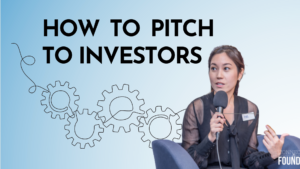How to Pitch to Investors



At the Pitching to Investors session of the Women in Business series on December 14th, 2016, Tee Plern Suraphongchai, partner at Venturra, a USD 150 million venture capital fund, and previously of Ardent Capital, a Bangkok-based investment fund, discussed how to structure a Pitch and what to consider.
K. Tee started by saying that every investor is different so there is not one right way to talk to them. Some investors are focused on seed funding, while others – such as Venturra – are focused on series A and series B. This affects both the size of the funding they provide as well as the type of information they will be looking for from a potential investee.
Venture investing is a high risk by nature and while you might many startup success stories in the news, the truth is that there are more failures than successes. The environment is very competitive and dynamic and sometimes businesses fail due to external circumstances outside their control. In the US, traditional venture firms expect that about 30% of their investments will fail, 30% will just return the capital invested, and the rest will likely succeed and those will produce their returns.
So what does an investor typically look for in a pitch?
Market Opportunity – How big the opportunity is and the business side.
- Market size.
- Business model.
- Competition
- Execution
The Entrepreneur – Who are you and where are you going to take it.
- Experience
- Team
- Thought Process
- Passion
Market Size. Here you explain in a very quantifiable way – in dollar terms – how big the market you are planning to serve is right now and could become in the 3-5-10 year horizon. How can you quantify market size? Let’s say you are in e-commerce. Look at the volume of retail sales in Thailand and the percentage of online retail. That’s your current opportunity. To look at what it might become in the future, look at more developed markets such as China and the US and their percentage of online retail. This is what Thailand e-commerce could potentially grow to. These are the numbers that every investor wants to know, particularly if you are in a niche business.
Business Model. Even within a certain sector there are different ways that you could make money. Sometimes it’s a subscription service; sometimes it’s a per fee basis; sometimes it’s something else. It’s what you think that makes sense for you and your customers. You should know your numbers inside out when you talk to investors.
Competition. Investors would like to understand who else is in this space, who you are competing against, and how you might differ or resemble each one of them. This is how investors look at managing our risks and returns.
Execution. This varies depending on the stage of your business. At the seed level, if you are doing the idea stage there is no proof of execution yet. When you are at series A or B investors want to see at least some revenues and understand the unique features of your business to make sure that you are able to achieve what you are set out to do.
Experience. Investors want to know that you actually understand the business and have experience in that particular domain. General entrepreneurship experience could also be applicable. Experience can be looked at through various lenses. For example, you might be right out of college with no prior work experience but you know your market really well, you might understand a certain demographics very well.
Team. Investors want to know not only you as a founder but also who you have surrounded yourself with, their relevant experience, and how you will build this business together. Investors want to see a clear separation of responsibilities and how you complement each other. Venturra also asks how long the team members have known each other. This is a very high stress, high risk business so if you don’t know your cofounders very well, there is a very high risk that you could have a conflict and split. If you have known each other and worked together for several years, the chances of this happening are much lower.
Thought process. This allows an investor to understand a bit how an entrepreneur might think. When you are building a new business, there are so many unknowns. When investors ask questions, it’s not really about what the answers are because we know that often you don’t really know the answers. It’s about how you go about tackling those questions. For example, the valuation question – how much do you think your business is worth and what is this valuation based on?
Passion. This is very, very important. Being an entrepreneur is very hard and for us it’s really about passion and how much you are willing to put into it.



Make sure you choose your investors wisely
There are many different kinds of investors –angel investors, VCs, corporate investors, etc. Everyone has different interests and goals in mind so you need to understand the peculiarities of every investor you talk to – their interests, what check size they write, what kind of geographical or sectoral focus they have, and how they can help you. VC is a class of investors that have a certain level of expectations. Venture investing is high risk and as result, we look for very high returns. There are businesses that might be very strong but can grow at a slower pace – instead of raising VC, they can raise from a different type of investors that might be a better fit.
Also, raising equity is not a one-sided relationship. You might be giving up a substantial portion of your business and you are typically in for the long-run – an equity investment is like a marriage. Just as investors are going to do a due diligence process on you, you should also do a due diligence process on them.
How long does it take to raise venture capital?
Depending how much money you are raising, it takes a different amount of time. If someone is writing a USD 200-300,000 check, it doesn’t take the same amount of time as if someone is writing a USD 2-3 million check. We recommend allowing at least 3 months for a seed round and at least 6 months for Series A.
When should a business start raising capital?
If you have the option to bootstrap, that’s fantastic because not many people have that on the table. When you are looking at bootstrapping versus taking outside money, you should look at it as a trade-off – how much control you are willing to cede versus how quickly you can scale and accelerate your business. It also depends on the nature of the business. In some sectors, there is a lot of advantage to speed. If you are in a relatively new sector, where you know a lot of competition is going to come in the next few months or a year, maybe it’s better to raise now because time is an important factor.
It’s also a matter of what kind of capital is available to you – who the investors are and what contribution they can bring as well. Losing the control is not a huge deal if you can grow the piece of the pie and if you have the right investors because they should be on the same side and make sure that you maintain a certain level of equity as well. People always think that it’s a zero-sum game between a company and investors but I don’t think it’s necessarily true. For me, I don’t want my investors to get too diluted because otherwise it’s a case of misaligned incentives. If you have too small of a piece of the pie, you are not going to work as hard as I need you to.
What do you offer in addition to capital?
We help our investees with anything and everything. Generally, if we take a pretty big lead position we sit on the board. Other than that, we help on a lot of other things that they might not have expertise in. We don’t micromanage – we invest in an entrepreneur because we believe they have the ability to run and build their business but there might be certain areas where they might need support – fundraising, for example. We also help them a lot with introductions, either to other investors for future rounds or business partners as well. We also help with hiring and finding key personnel. And this is probably one of the key challenges for startups – how to find key people as you grow.





